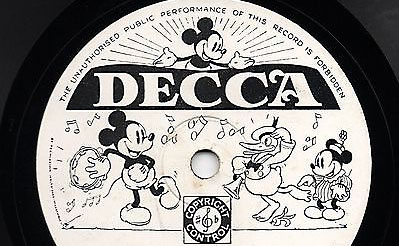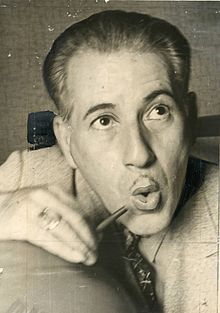Suspended Animation # 217

When helping my friend and fellow historian Brian Sibley on a project, I contacted the always knowledgeable Keith Scott and learned something new. It is always good to have friends and I am always grateful for the ones I have who are always so willing to help. Brian and Keith are two of the best.
In the South Eastern Times newspaper for Tuesday August 23, 1932, it states:
“Mickey Mouse, or rather his voice arrived in London recently. He is Count Mazzaglia Cutelli, an Italian, who can produce from his throat more than 2,000 sound effects.
“Count Cutelli has been Mickey Mouse’s screen voice ever since the count went to Hollywood, and since then, besides his Mickey Mouse work, he has been producing sound effects like the bulldogs’ chorus in “The Love Parade” and the croaking of a bull frog in “Condemned”. ‘I spent years learning the exact noises produced by every type of dog and cat and hundreds of other animals,’ he told a reporter. ‘I have supplied sound effects for Miss Mary Pickford’s films and for Mr. Douglas Fairbanks and the voice of the crying baby Abraham Lincoln in the film of that name was mine’.”
For roughly the first year of his screen career, Mickey just squeaked. That squeak was provided by Walt Disney. Mickey never said a word until July 1929 in The Karnival Kid: “Hot Dog!”
 While both Carl Stalling and Clarence Nash apparently stepped in on occasion to do a pick up line or a song when Walt was not available, Count Cutelli is not mentioned in any other source other than that short self-promoting newspaper interview as ever doing Mickey Mouse’s voice.
While both Carl Stalling and Clarence Nash apparently stepped in on occasion to do a pick up line or a song when Walt was not available, Count Cutelli is not mentioned in any other source other than that short self-promoting newspaper interview as ever doing Mickey Mouse’s voice.
Cutelli was adept at doing voice work for cartoons and did some for producer Leon Schlesinger at Warner Brothers.
Cutelli claimed he did some work on the early version of Porky Pig which would have had to have been augmenting some of the original work done by Joe Dougherty who had an actual stuttering problem but couldn’t control it.
As a result, some recording sessions took hours and added to the costs so Cutelli could have been brought in for some additional lines. Dougherty only voiced the character for two years from March 1935 to March 1937. He was replaced in early 1937 by Mel Blanc who could provide a more consistent stutter.
Cutelli, of course, claimed that he was the one who voiced the original “That’s All Folks” tag at the end of Looney Tunes cartoons. He may be right but there is no one left or any documentation to definitely confirm his claim.
Voice artist and historian Keith Scott has in his collection a photo of Leon autographed to Cutelli with an inscription calling him a “great artist and a fine fellow”.
 Gaetano Mazzaglia dei Conti Cutelli was born in Sicily, Italy and grew up on his father’s estate near Mount Etna. He was raised as a nobleman within the Italian aristocracy. He came to the United States in 1923.
Gaetano Mazzaglia dei Conti Cutelli was born in Sicily, Italy and grew up on his father’s estate near Mount Etna. He was raised as a nobleman within the Italian aristocracy. He came to the United States in 1923.
He was notriously adept as a self-promoter which perhaps helped him earn his nickname of “The Big Noise”. Actually, the nickname referred to his versatility in doing sound effects.
In 1931, he told American Magazine, “I began to imitate sounds when I was a small boy in Sicily. Then I became a sea captain and learned the sounds of the sea.
“I went on stage at Palermo just for the fun of it. I gave some of my sound imitations and the audience seemed to like them. Finally, I came to America. Gloria Swanson’s manager called me and asked me to cry like a baby as I had on a radio broadcast he heard. It registered so realistically that I was engaged. I had found an outlet for my childhood hobby.”
His repertoire of sounds included not just animals but mechanical and weather effects. He developed devices to replicate these sounds for radio and film and sometimes hosted seminars with producer Leon Schlesinger about these machines which were smaller, cheaper and with more variety than the other models of the time. In 1935, he developed the sound effects machine used at station WGN in Chicago.
He died of a heart attack while at a Seattle railway station waiting for a train to Vancouver at the age of 55 on July 16, 1944. The Chicago Tribune on July 17th declared “Genius of Sound Effects Dies”.
 As pointed out by Keith Scott, in the November 1932 Decca records catalogue supplement, it lists a 10-inch blue label record titled MICKEY MOUSE DISCOVERS A NEW LAND backed with MICKEY MOUSE ON THE ISLAND OF THE POLAR BEARS, [by] Count Mazzaglia Cutelli of Mickey Mouse Fame (Novelty Cartoon Record). It was listed as Record No. F3175
As pointed out by Keith Scott, in the November 1932 Decca records catalogue supplement, it lists a 10-inch blue label record titled MICKEY MOUSE DISCOVERS A NEW LAND backed with MICKEY MOUSE ON THE ISLAND OF THE POLAR BEARS, [by] Count Mazzaglia Cutelli of Mickey Mouse Fame (Novelty Cartoon Record). It was listed as Record No. F3175
The description states: “At last the effects side of the Mickey Mouse cartoons have been recorded by the originator of the effects, Count Cutelli. Indeed this unique record should have universal appeal, irrespective of age and class. It should be stated that all effects are devised and performed by Count Cutelli, and they are exactly as they appear in the series of talking films under the general title of Mickey Mouse.”
However that same catalogue also includes the following added notice:
 “This record has been withdrawn as it has come to the notice of the Decca Record Co. Ltd. that Count Mazzaglia Cutelli is not connected with and has no authority from Mr. Walter Disney the originator of Mickey Mouse to use the name of Mickey Mouse or make any record purporting to reproduce the sound effects employed in the Mickey Mouse pictures.
“This record has been withdrawn as it has come to the notice of the Decca Record Co. Ltd. that Count Mazzaglia Cutelli is not connected with and has no authority from Mr. Walter Disney the originator of Mickey Mouse to use the name of Mickey Mouse or make any record purporting to reproduce the sound effects employed in the Mickey Mouse pictures.
“The Decca Record Co. Ltd. begs to announce that at the request of Mr. Disney all copies of this record have been destroyed and takes this opportunity of expressing to users of Decca Records the company’s regret that this record should ever have been issued as representing or reproducing the sound effects of the Mickey Mouse cartoons.”
Now, that is not to say that Cutelli never worked at the Disney Studio. He apparently did supply some background sounds in the early Disney cartoons but probably primarily the Silly Symphonies series.
Thanks to Mickey biographer extrordinaire David Gerstein, here are those rare Cutelli recordings:
Additionally, here are a few surviving (authorized?) French recordings Cutelli was involved with:
A memo to Roy Scott from Walt Disney dated December 23, 1935 states:
“Here’s a fellow, Count Cutelli, who might have something we could use in Snow White. He did some stuff for us several years ago and he’s really pretty good. I know he does a good frog. But there’s one thing about this fellow you’ll have to watch and that is he’s inclined to publicize whatever he does.
“If he works with us, though, we’ll straighten him out on this angle. Might take him into Pinto (Colvig who was handling voices at the time) and see what he can do. Anyway, have a talk with him and see if you figure out anything.”
It is unclear whether he ever did any work of any kind on Snow White and the Seven Dwarfs. Cutelli, if he is remembered at all, may receive recognition not for his vocal work in animated cartoons but for the installation of his sound effects equipment (personally installed by him) in the radio stations in countries around the world.
You can actually see and hear Cutelli perform on this 1932 Pathe newsreel clip:


 Jim Korkis is an internationally respected animation historian who in recent years has devoted his attention to the many worlds of Disney. He was a columnist for a variety of animation magazines. With his former writing partner, John Cawley, he authored several animation related books including The Encyclopedia of Cartoon Superstars, How to Create Animation, Cartoon Confidential and Get Animated’s Animation Art Buyer’s Guide. He taught animation classes at the Disney Institute in Florida as well as instructing classes on acting and animation history for Disney Feature Animation: Florida.
Jim Korkis is an internationally respected animation historian who in recent years has devoted his attention to the many worlds of Disney. He was a columnist for a variety of animation magazines. With his former writing partner, John Cawley, he authored several animation related books including The Encyclopedia of Cartoon Superstars, How to Create Animation, Cartoon Confidential and Get Animated’s Animation Art Buyer’s Guide. He taught animation classes at the Disney Institute in Florida as well as instructing classes on acting and animation history for Disney Feature Animation: Florida.




















































After listening to these clips, I am sure I’ve heard the vocal work of Count Cutelli in Warner Brothers cartoons, but my question is how early did he start at Leon Schlessinger’s studio? His rooster crow and donkey brays are familiar when applied to LOONEY TUNES shortly after ties to Hugh Harman and Rudy Ising were severed, but if he did work with Hugh and Rudy, I’d like to know, because there were always a lot of barnyard noises in those earliest LOONEY TUNES and MERRIE MELODIES titles…and how long did he work for Schlessinger? Since he also worked for Disney, he must have been working for both studios at once, because his sounds remind me of so many 1930’s titles. Since it is hard to find original closing credits on some of the two strip technicolor MERRIE MELODIES, we don’t know if it is possible that he did the “THAT’S ALL FOLKS” or “SO LONG FOLKS endings, but this post is very entertaining. Perhaps, with Keith Scott’s help, you could post a follow-up piece with examples of what he might have done for Walt Disney or Leon Schlessinger.
Perhaps Count Cutelli WAS a major supplier of animal sounds to the earliest audio cartoons, but I really can’t hear anything special or really outstanding in his performance. There must have been a small army of animal sound specialists in the late 1920s waiting for auditions in the cartoon studios’ sound departments. Count Cutelli may have been one of them. Thanks for a very interesting post, Jim!
I hope someone good at newspaper searches can finally find a story about another prominent barnyard animal specialist mimic in cartoons of the 1930s, whose name was Melvin J. Gibby. He was as obscure as Cutelli and Purv Pullen, but they did lots of West Coast cartoons, along with the ladies who were whistling specialists and did a lot of the birds we hear in animation. They include Marion Darlington, Dorothy Lloyd and Ruby Ray.
Evidently Mr. James Melvin Gibby wasn’t able to make a paying proposition of his career. He was originally from Utah and moved to Salt Lake City in 1945 to manage the Utah Woolen Mills. I’ve found a clipping or two about him emceeing Lions Club functions, with the notation “who recently was employed by a Hollywood cartoon maker.” No specifics. By 1958, he and his wife had moved back to southern California but returned to Utah to work in the accounting business and were in Ogden in 1970.
He published a book “Sand on the Rails.”
This guy was probably inclined to overstate his contributions a bit too much, which must have made him unpopular among some producers. Reminds me of the actor Harry Welch who claimed to voice Popeye that you posted about a while back. I don’t know why Disney wanted him after the story with the pulled Decca records, but he might have been too busy with his machines by then anyway.
P.S. At first I skimmed through the text and thought Roy Disney wrote the memo.